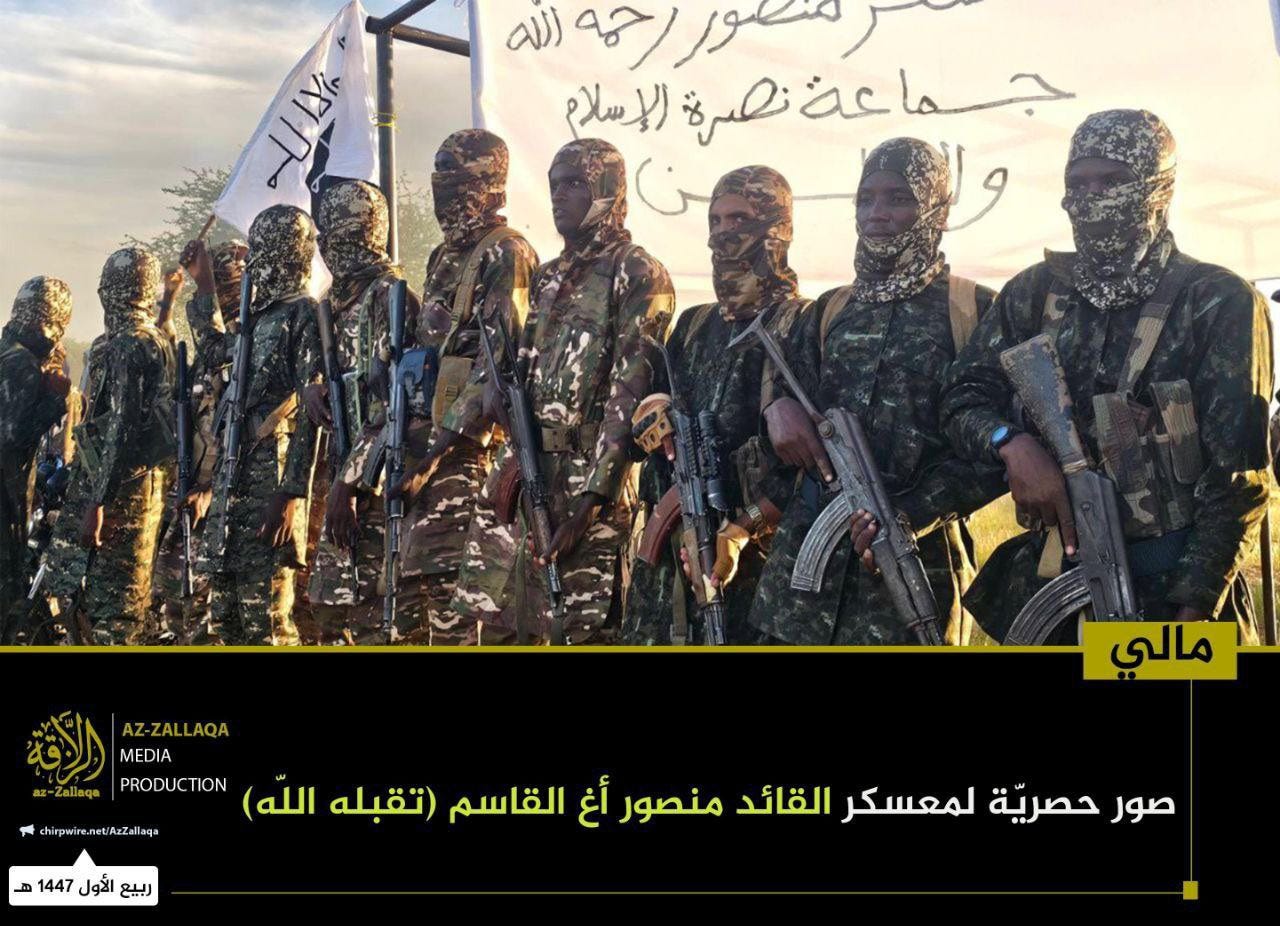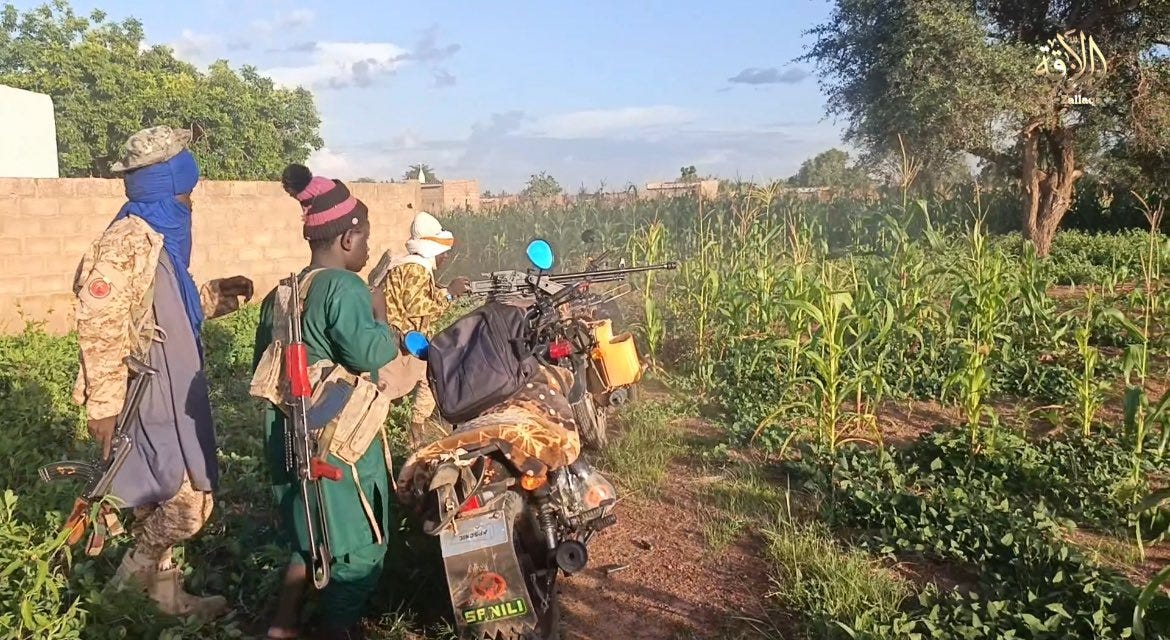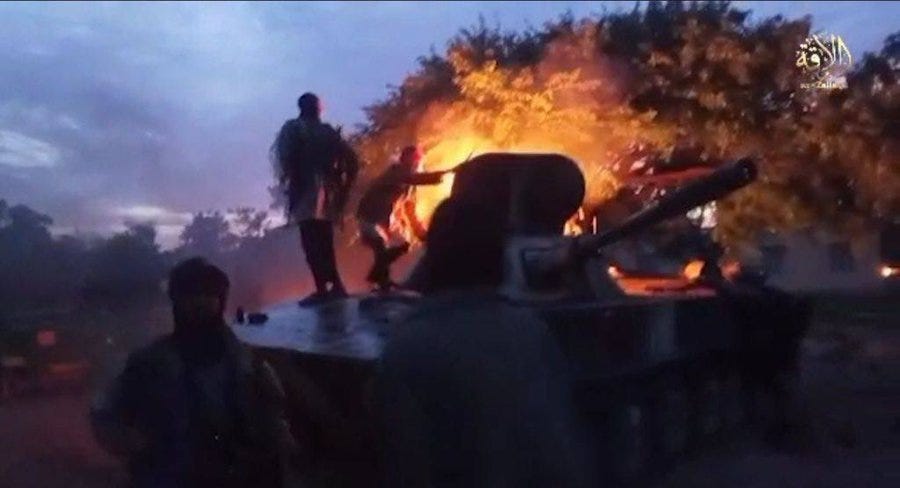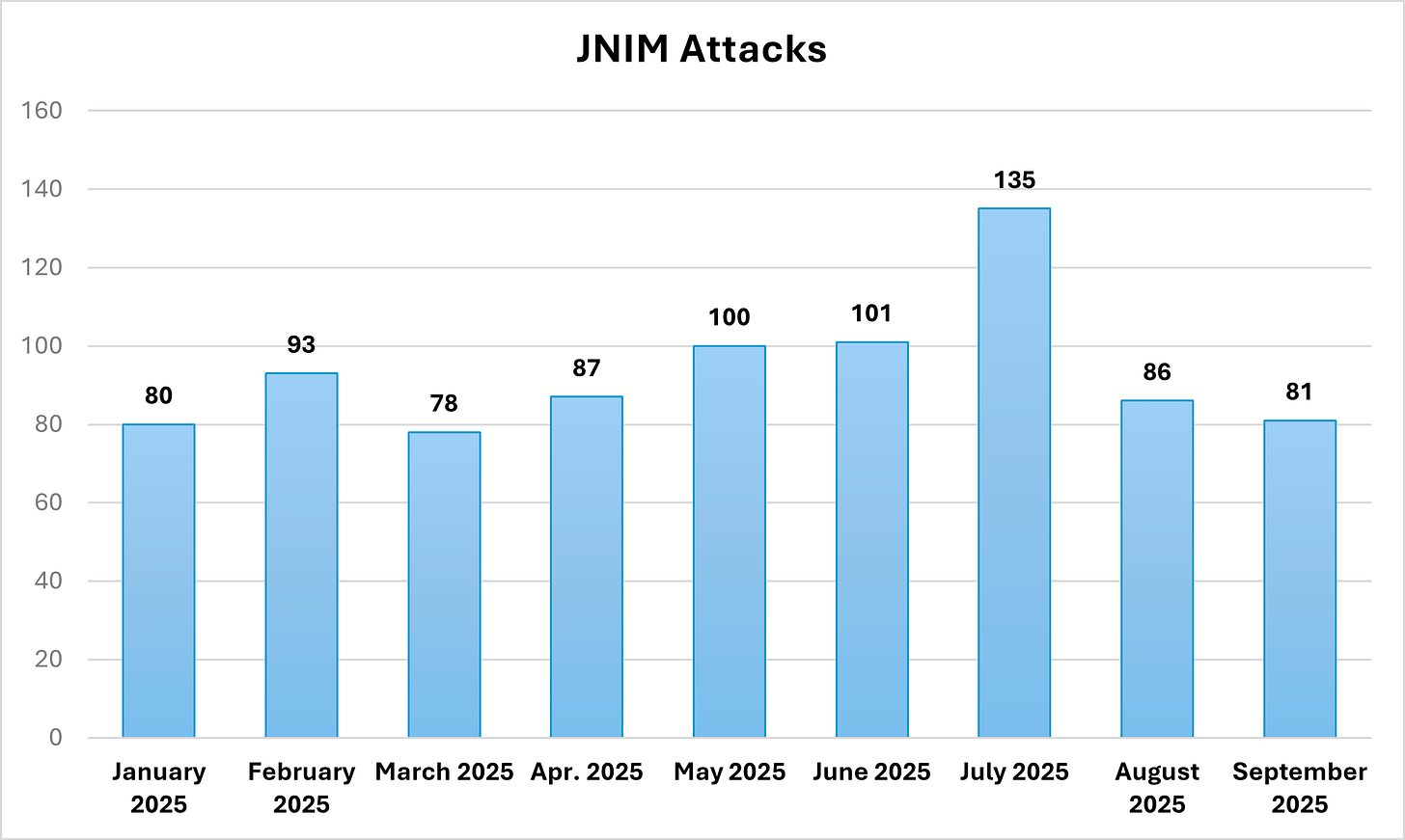Security Risk Monitoring and Threat Assessment: JNIM in Africa
Military Operations September 2025
Daniele Garofalo Monitoring is registered with the Italian National ISSN Centre and the Centre for the Registration of Serial Publications (CIEPS) in Paris.ISSN (International Standard Serial Number): 3103-3520ORCID Code: 0009-0006-5289-2874In recent years, Saharan and Sahelian areas have become increasingly important in threat assessment and risk expansion, particularly concerning Salafist-jihadist terrorism.
Objectives of the analysis: to assess the latest operational developments of Jama’at Nasr al-Islam wal Muslimin (JNIM) in its areas of operation in Africa.
Date: September 2025
Methodology: monitoring of jihadist propaganda (videos, photos, statements, claims) and reports from sources in the field.
Sources: open sources, primary sources available on JNIM channels and websites, official reports, local sources in the field.
Verification: cross-checking, date cross-checking, use of local and international sources.
Limitations: incomplete information (sometimes reports and claims by groups exaggerate numbers or do not claim activities that have actually been carried out), bias in sources, possibility of propaganda and disinformation.
Structure of the analysis: brief overview of the group, updates on recent military activity, analysis of the number of attacks, graphs and statistics, photos, areas, conclusions and assessments.
Organisations/groups:
Jama’at Nasr al-Islam wal Muslimin (JNIM).
Allied/Affiliated: Al-Qaeda.
Activity area:
Mali, Burkina Faso, Niger, Benin, Togo (activities have also been recorded in the past year in the Ivory Coast, Nigeria and Mauritania or on their borders).
Overview and Security Threat Assessments:
The many problems of popular discontent, economic and social vulnerabilities, etc. have been the basis of support for independence movements in the North in the past. They are also the basis for the recruitment of jihadist organisations today. The strongest of these is undoubtedly Jama’at Nasr al-Islam wal Muslimin (Group for the Support of Islam and Muslims - JNIM), a coalition of Salafist-jihadist rebel groups operating in the Sahel region of sub-Saharan Africa, particularly in Mali, Niger and Burkina Faso, but with attacks also conducted in recent years in Togo, Ivory Coast, Benin and Senegal. JNIM was founded in March 2017 by the merger of four Salafist-jihadist groups in the Sahel: Ansar Dine led by Iyad Ag Ghali, Ahmed Kouffa’s Katibat Macina, al-Mourabitoun and the Saharan branch of al-Qaeda in the Islamic Maghreb (AQIM). The JNIM has become very adept at conveying the discontent and demands of the poorer sections of the population and ethnic minorities, particularly the Tuareg and Fulani. Since its inception, the JNIM has extended its operational territory throughout West Africa, conducting a sustained campaign of violence against civilians, local security forces, international armies and UN peacekeepers. The Qaedist affiliate in the area has managed to progressively insert itself into the complex Malian context, presenting itself as a credible and legitimate alternative to both the government in Bamako and the rebel movements. The JNIM managed to operationalise local demands, while the responses to the insurgency failed to address the political causes of the conflict and encouraged human rights violations.
The expansion of the JNIM in northern Mali and the Sahelian area is linked to social, political and economic factors rather than ideological factors. Jihadist groups have managed to create an alternative and more efficient welfare system than that of the central government, through the distribution of necessities and care services, employment, education (always linked to radicalism), the administration of justice, and the defence of communities and minorities. The latter has allowed the JNIM to assimilate, manoeuvre and revive the old nationalist claims of minorities, offering them political and logistical support and, in most cases, taking control of the territory and the fight against the government in Bamako. The leadership of the Qaedist group was assumed by Iyad Ag Ghaly, one of the most influential Malian Tuareg leaders, former leader of Anṣār al-Dīn and former lieutenant of Osama bin Laden for Africa. Many minorities facilitate JNIM operations in Mali, and some spread outside Mali, giving the group access to a wide collaboration network.
Over the years, JNIM has significantly increased its operations and attacks throughout the country, not only in the north but often pushing into neighbouring countries. The organisation uses a federalist and para-state organisational model, imposing direct control of the territory to better manage, directly or indirectly, the trafficking of migrants, drugs and weapons, which it exploits to feed its structure and finance its activities.
The JNIM was created precisely to better coordinate the activities of the numerous jihadist groups in the area, optimising recruitment and proselytising in the Sahelian area. JNIM attacks are mainly directed against military infrastructure, convoys of local armies and civilian targets in major Malian and Burkinabé cities, and against MINUSMA and Wagner. The latter has increased the consensus and recruitment of the JNIM in the area due to its excessive violence. Violence against civilians increased after the arrival of the Russian mercenary group. Wagner’s attacks have targeted Fulani civilian communities mainly because of his alleged links to the armed jihadist group Jama’at Nusrat al-Islam wal-Muslimin (JNIM), composed of the Massena and Sirma factions. The different patterns of violence in the north and centre of Mali and Burkina Faso reflect the multiple structures of terrorist alliances in those regions. The north is controlled by the command and operations of JNIM leader Ghali, whose strategy has focused on attacking foreign forces and making deals with key figures such as militia and political and religious leaders. However, Amadou Koufa operates in central Mali and Burkina Faso as a field commander and imam and as the creator of a different kind of strategy that draws support from the ethnic minorities, who triggered the conflict.
The expansion and escalation of JNIM violence has become increasingly intense since August 2023, with the spread of the call for general mobilisation for jihad in Mali, published on 21 August by the Jama’at Nusrat ul-Islam wa al-Muslimin (JNIM) propaganda channel, az-Zallaqa Media, which led to a significant increase in military operations by Al Qaeda’s affiliate in the Sahel between September and November 2023, with strong growth in 2024. JNIM seeks to broaden its social support base among the population and establish itself as a political actor, not just an armed structure. JNIM seeks to broaden its social support base among the population and establish itself as a political actor, not just an armed structure.
In 2025, JNIM is carrying out increasingly significant attacks, in addition to stepping up attacks against economic targets (mainly against Chinese and Russian investors). Since July 2025, JNIM has expanded the scope of its activities, demonstrating its ability to threaten the region’s main economic and strategic centres.
The attacks on the Kayes region and industrial facilities (during which foreign workers were kidnapped) were a further threat to Bamako. Kayes is Mali’s main logistics hub, important both for trade with Senegal and for gold mining. JNIM’s leadership is well aware of the region’s importance. The growing activity in the Ségou region shows the constant advance and growing threat of JNIM. In recent months, Jama’at Nusrat al-Islam wal-Muslimeen (JNIM) has increased pressure on the Malian government by launching an economic warfare campaign. Since May, the extremist group has attacked factories, industrial facilities, infrastructure projects and artisanal gold mining sites, mainly located in western Mali, the economic heart of the country. Many of the targets were linked to international organisations, which were warned in a public statement earlier this summer that they would no longer be able to operate in Mali without JNIM’s authorisation. On 3 September, JNIM spokesman Abu Hamza al-Bambari announced an expansion of the campaign, stating that the group would begin targeting fuel supplies from neighbouring countries: Senegal, Côte d’Ivoire, Guinea and Mauritania. He also confirmed his intention to continue the blockade of the cities of Kayes and Nioro, which began on 1 July, and warned Malians against using buses operated by a well-known local company.
Since then, JNIM has taken significant steps to carry out its threats: videos quickly appeared online showing jihadists setting fire to fuel trucks, buses and cars in the western and southern parts of the country. There have also been reports of drivers being kidnapped at improvised checkpoints.
Given the country’s heavy dependence on fuel and goods imported from neighbouring states, JNIM’s campaign has become a serious, and perhaps existential, challenge for the military junta. The solution is unclear: protecting slow convoys on vast, long and poorly maintained roads is virtually impossible.
Despite conflicting statements from the governments of the countries involved in the threat, the strength of JNIM, in terms of territorial control and military force, continues to grow and expand, allowing it to attack without difficulty in many areas of Mali and Burkina Faso, while also aiming to expand into Niger, Benin, and Togo. The strength and expansion of JNIM, in terms of territorial control and military force, continues unabated.
In recent months, JNIM has demonstrated a new level of coordination, conducting operations hundreds of kilometres apart. The attacks underscore the group’s desire to expand its activities in central and western Mali, which were previously less affected by large-scale violence. This shows JNIM’s confidence in its own strength and a significant strengthening of its armed potential compared to the past.
Of note, the use of drones for aerosurveillance and to guide attacks is increasing. The increase in JNIM attacks and their greater effectiveness are also due to the way JNIM operates. Its tactics involve the use of small, highly mobile attack teams that attack in a “swarm”, using motorcycles and pick-up trucks. This “swarm” moves chaotically and quickly around the target, creating an encircling effect. Communication between teams is via radio and telephone, and the situation on the ground is monitored by drones and ground observers. The types of attacks are carried out using IEDs and ambushes against convoys or individual patrol vehicles, raids on villages in areas populated by pro-government militias, targeted killings, attacks on bases, camps and checkpoints of regular armies or pro-government or private militias using suicide car bombs, artillery or mortar attacks, drone attacks and direct assaults. These tactics make them difficult to predict and extremely effective.
Number of attacks in September 2025: 81
All the attacks were followed by extensive propaganda, in particular, JNIM published in this month: 73 statements claiming the 81 attacks carried out and 61 photos and 8 videos documenting the achievements. As of June 23, Az-Zallaqa Media introduced a completely new look, new colors and new photo backgrounds for its videos, statements and photos.
Targets:
JNIM’s military objectives this month have been many, and they are as follows:
Malian army (FAMa), Russian PMC Africa Corps, Burkinabè Army, Niger Army, VDP militia.
Area:
JNIM hit the following countries this month:
MALI: Sikasso region, Ségou region, Kayes region, Mopti region, Koulikoro region;
BURKINA FASO: Yatenga province, Mouhoun province, Gourma province, Ouahigouya province, Soum province, Sissili province, Sanmatenga province, Bam province, Namentenga province, Comoé province:
NIGER: Tillaberi region, Agadez region.
Conclusion: Security Threat Assessments
Al-Qaeda’s affiliate in the Sahel continues to demonstrate strong and growing military capabilities in the region. JNIM’s strength, both in terms of territorial control and military power, remains unchanged (as evidenced by numerous photos and videos documenting military, training and Da’wah activities) and it has been able to launch violent attacks in different areas and at different times, including highly complex attacks, most recently with the aid of drones, using hundreds of militants and even at night.
This month, the number of attacks remained constant compared to last month, but they increased in terms of violence and complexity. Official and unpublished videos on various channels show an increasing use of drones and SVBIEDs, and bases and barracks have also been targeted more frequently. This month, there were no attacks in Benin and Togo and against the rival Islamic State terrorist group. Mali and Burkina Faso remain the most affected countries.
The military operations conducted by JNIM (and recently also economic warfare) demonstrate that the group has undisputed military capabilities and that the counter-terrorism activities of the army, pro-government militias or private militias are currently unable to curb it.
JNIM is increasingly seeking to expand its areas of activity, and its growth could indicate a desire to launch new offensives in areas not yet under its control, as well as in neighbouring countries.
© Daniele Garofalo Monitoring - All rights reserved.
Daniele Garofalo is a researcher and analyst on Jihadist Terrorism, Islamist Insurgents and Armed Groups. He is an expert in Monitoring Jihadist Media Channels, Islamist rebels, and Armed Groups.
Daniele Garofalo Monitoring is registered with the Italian National ISSN Centre and the International Centre for the Registration of Serial Publications (CIEPS) in Paris.
ISSN (International Standard Serial Number): 3103-3520
ORCID Code: 0009-0006-5289-2874
Support my research, analysis and monitoring with a donation here PayPal.Me/DanieleGarofalo88







